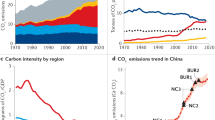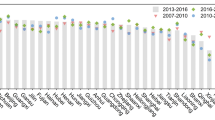Abstract
China committed itself to reduce the carbon intensity of its economy (the amount of CO2 emitted per unit of GDP) by 40–45% during 2005–2020. Yet, between 2002 and 2009, China experienced a 3% increase in carbon intensity, though trends differed greatly among its 30 provinces. Decomposition analysis shows that sectoral efficiency gains in nearly all provinces were offset by movement towards a more carbon-intensive economic structure. Such a sectoral shift seemed to be heavily affected by the growing role of investments and capital accumulation in China’s growth process which has favoured sectors with high carbon intensity. Panel data regressions show that changes in carbon intensity were smallest in sectors dominating the regional economy (so as not to endanger these large sectors, which are the mainstay of the provincial economy), whereas scale and convergence effects played a much smaller role.
This is a preview of subscription content, access via your institution
Access options
Subscribe to this journal
Receive 12 print issues and online access
$209.00 per year
only $17.42 per issue
Buy this article
- Purchase on Springer Link
- Instant access to full article PDF
Prices may be subject to local taxes which are calculated during checkout

Similar content being viewed by others
References
Intergovernmental Panel on Climate Change, Climate Change 2007: Synthesis Report (IPCC, 2007).
UNFCCC Part Two: Action taken by the Conference of the Parties at its fifteenth session (United Nations Framework Convention on Climate Change, 2010).
Geng, Y. Eco-indicators: Improve China’s sustainability targets. Nature 477, 162 (2011).
Qiu, J. China unveils green targets. Nature 471, 149 (2011).
Liu, Z. et al. Energy Policy: A low-carbon roadmap for China. Nature 500, 143–145 (2013).
Yi, W-J., Zou, L-L., Guo, J., Wang, K. & Wei, Y-M. How can China reach its CO2 intensity reduction targets by 2020? A regional allocation based on equity and development. Energy Policy 39, 2407–2415 (2011).
Wang, K., Zhang, X., Wei, Y-M. & Yu, S. Regional allocation of CO2 emissions allowance over provinces in China by 2020. Energy Policy 54, 214–229 (2013).
Wei, C., Ni, J. & Du, L. Regional allocation of carbon dioxide abatement in China. China Econ. Rev. 23, 552–565 (2012).
Yuan, J., Hou, Y. & Xu, M. China’s 2020 carbon intensity target: Consistency, implementations, and policy implications. Renew. Sust. Energy Rev. 16, 4970–4981 (2012).
Dong, F., Long, R., Chen, H., Li, X. & Yang, Q. Factors affecting regional per-capita carbon emissions in China based on an LMDI factor decomposition model. PLoS ONE 8, e80888 (2013).
Zheng, X., Yu, Y., Wang, J. & Deng, H. Identifying the determinants and spatial nexus of provincial carbon intensity in China: A dynamic spatial panel approach. Reg. Environ. Change 14, 1651–1661 (2014).
Guan, D. & Barker, T. S. Low Carbon Development in the least developed region: A case study of Guangyuan, Sichuan province, southwest China. Nat. Hazards 62, 243–254 (2012).
Minx, J. C. et al. A Carbonizing Dragon: China’s fast growing CO2 emissions revisited. Environ. Sci. Technol. 45, 9144–9153 (2011).
Krugman, P. The New York Times (18 December 2011).
National Bureau of Statistics China Statistical Yearbook 2010 (China Statistics Press, 2011).
Peters, G., Guan, D., Hubacek, K., Minx, J. & Webber, C. Effects of China’s economic growth. Science 328, 825–826 (2010).
Wang, Q. & Chen, Y. Energy saving and emission reduction revolutionizing China’s environmental protection. Renew. Sust. Energy Rev. 14, 535–539 (2010).
Feng, K. et al. Outsourcing CO2 within China. Proc. Natl Acad. Sci. USA 110, 11654–11659 (2013).
Meng, B., Xue, J., Feng, K., Guan, D. & Fu, X. China’s inter-regional spillover of carbon emissions and domestic supply chains. Energy Policy 61, 1305–1321 (2013).
An, H. & Nu, L. Xinjiang thermal power industry SO2 D ~ charge present situation and control countermeasure [in Chinese]. Environ. Prot. Xinjiang 27, 22–25 (2005).
Peters, G., Webber, C., Guan, D. & Hubacek, K. China’s growing CO2 emissions—a race between lifestyle changes and efficiency gains. Environ. Sci. Technol. 41, 5939–5944 (2007).
International Cement Review The Global Cement Report Ninth Edition. (Tradeship Publications Ltd, 2011).
Liu, J. & Diamond, J. Revolutionizing China’s environmental protection. Science 319, 37–38 (2009).
Tan, X. et al. Scaling Up Low-Carbon Technology Deployment: Lessons from China (World Resources Institute, 2011).
Ueno, T. Technology Transfer to China to Address Climate Change Mitigation (The Climate Policy Program, Resources for the Future, 2009)
Jacques, D. A., Guan, D., Geng, Y., Xue, B. & Wang, X. Inter-provincial clean development mechanism in China: A case study of the solar PV sector. Energy Policy 57, 454–461 (2013).
Guan, D. & Hubacek, K. China can offer domestic emission cap-and-trade in post 2012. Environ. Sci. Technol. 44, 5327 (2010).
Cui, L-B., Fan, Y., Zhu, L. & Bi, Q-H. How will the emissions trading scheme save cost for achieving China’s 2020 carbon intensity reduction target? Applied Energy (in the press).
Hoekstra, R. & van den Bergh, J. C. J. M. Comparing structural and index decomposition analysis. Energy Economics 25, 39–64 (2003).
Dietzenbacher, E. & Los, B. Structural decomposition techniques: Sense and sensitivity. Econ. Syst. Res. 10, 307–323 (1998).
Ang, B. W. The LMDI approach to decomposition analysis: A practical guide. Energy Policy 33, 867–871 (2005).
Hoekstra, R. & van den Bergh, J. C. J. M. Structural decomposition analysis of physical flows in the economy. Environ. Res. Econ. 23, 357–378 (2002).
National Bureau of Statistics China Energy Statistical Yearbook 2010 (China Statistics Press, 2011).
National Bureau of Statistics China Energy Statistical Yearbook 2003 (China Statistics Press, 2004).
China Economic Census Office of the State Council China Economic Census Yearbook 2008 (China Statistics Press, 2011).
Guan, D., Liu, Z., Geng, Y., Lindner, S. & Hubacek, K. The gigatonne gap in China’s carbon dioxide inventories. Nature Clim. Change 2, 672–675 (2012).
Guan, D., Hubacek, K., Weber, C. L., Peters, G. P. & Reiner, D. M. The drivers of Chinese CO2 emissions from 1980 to 2030. Glob. Environ. Change 18, 626–634 (2008).
Weber, C. L., Peters, P. G., Guan, D. & Hubacek, K. The contribution of Chinese exports to climate change. Energy Policy 36, 3572–3577 (2008).
Liu, Z., Geng, Y., Lindner, S. & Guan, D. Uncovering China’s greenhouse gas emission from regional and sectoral perspectives. Energy 45, 1059–1068 (2012).
Lindner, S., Liu, Z., Guan, D., Geng, Y. & Li, X. CO2 emissions from China’s power sector at the provincial level: Consumption versus production perspectives. Renew. Sust. Energy Rev. 19, 164–172 (2013).
Acknowledgements
The authors acknowledge support from China’s National Basic Research Program (2014CB441301 and 2010CB951803) and the National Natural Science Foundation of China (41328008, 41222036, 71325006 and 71033004). D.G. acknowledges the Collaborative Innovation Centre for Global Change Studies and ESRC funded project of the Centre for Climate Change Economics and Policy. S.K. acknowledges support from the German Ministry of Science and Technology as part of the ’Entdeken’ Project. Z.L. acknowledges the Giorgio Ruffolo fellowship and support from the Italian Ministry for Environment, Land and Sea. Q.Z. and K. He acknowledge support from the Collaborative Innovation Centre for Regional Environmental Quality.
Author information
Authors and Affiliations
Contributions
D.G., S.K. and K. Hubacek designed the research; D.G., Z.L. and Q.Z. compiled the data; D.G. and K. Hubacek performed initial decomposition analysis and produced early drafts; S.K. performed panel data analysis; all authors contributed to interpretation of the results and writing.
Corresponding authors
Ethics declarations
Competing interests
The authors declare no competing financial interests.
Supplementary information
Rights and permissions
About this article
Cite this article
Guan, D., Klasen, S., Hubacek, K. et al. Determinants of stagnating carbon intensity in China. Nature Clim Change 4, 1017–1023 (2014). https://doi.org/10.1038/nclimate2388
Received:
Accepted:
Published:
Issue Date:
DOI: https://doi.org/10.1038/nclimate2388
This article is cited by
-
Does the low-carbon city pilot contribute to the blue sky defense? Evidence from China
Environmental Science and Pollution Research (2023)
-
Carbon peak and its mitigation implications for China in the post-pandemic era
Scientific Reports (2022)
-
What drives the export-related carbon intensity changes in China? Empirical analyses from temporal–spatial–industrial perspectives
Environmental Science and Pollution Research (2022)
-
Short-run forecast and reduction mechanism of CO2 emissions: a Chinese province-level study
Environmental Science and Pollution Research (2022)
-
Exploring the consumption-based carbon emissions of industrial cities in China: a case study of Tianjin
Environmental Science and Pollution Research (2021)



